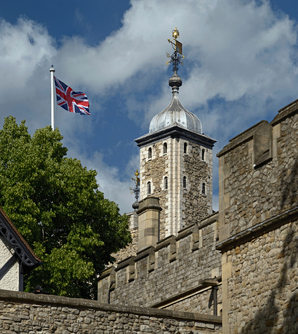St Peter’s Chapel, officially known as the Chapel Royal of St Peter ad Vincula, is a significant historical site within the Tower of London. Dating back to the 9th century, this Tudor-style chapel has witnessed over a millennium of English history. It serves as the final resting place for notable figures, including three queens of England, and continues to function as a place of worship for Tower residents. The chapel’s architecture, rich history, and cultural importance make it a must-visit attraction for those exploring the Tower of London complex.
What is the Historical Significance of St Peter’s Chapel?

St Peter’s Chapel boasts a long and complex history spanning over a thousand years:
- Pre-Norman origins: Possibly dating back to a 9th-century Saxon chapel
- Norman rebuilding: Henry I constructed a new chapel outside the Tower walls in 1128
- Medieval reconstruction: Edward I built a new chapel within the Tower walls in 1286-1287
- Tudor reconstruction: Current building erected between 1519-1520 after a fire in 1512
- Victorian restorations: Major renovations in 1841 and 1876
- Modern conservation: Further restorations in the 1970s and 2014
The chapel has served as a place of worship for generations of Tower residents and has been the final resting place for numerous historical figures executed within the Tower.
What Architectural Features Define St Peter’s Chapel?

St Peter’s Chapel exemplifies Tudor architecture with several distinctive features:
- Nave and shorter north aisle
- Windows with cusped lights but no tracery
- Short tower at the west end with a lantern bell-cote
- Spanish chestnut roof resembling trees from Queen Katherine of Aragon’s homeland
- Original decorative arches and some original windows
- Piscina and hagioscope, indicative of Catholic origins
The chapel’s interior houses important monuments and tombs, including those of:
- Sir Richard and Elizabeth Cholmondeley
- Three queens of England: Anne Boleyn, Catherine Howard, and Lady Jane Grey
- Notable historical figures: Sir Thomas More, John Fisher, and Thomas Cromwell
Who is Buried in St Peter’s Chapel?
St Peter’s Chapel is renowned for being the final resting place of several prominent historical figures. Here’s a table of some notable individuals buried within the chapel:
| Name | Title/Position | Year of Death |
|---|---|---|
| Anne Boleyn | Queen of England | 1536 |
| Catherine Howard | Queen of England | 1542 |
| Lady Jane Grey | Queen of England (disputed) | 1554 |
| Sir Thomas More | Lord Chancellor of England | 1535 |
| John Fisher | Bishop of Rochester | 1535 |
| Thomas Cromwell | Chief Minister to Henry VIII | 1540 |
These burials contribute significantly to the chapel’s historical importance and make it a focal point for visitors interested in Tudor history.
What is the Current Role of St Peter’s Chapel?
Today, St Peter’s Chapel serves multiple roles:
- Parish Church: It continues to function as the parish church for residents of the Tower of London.
- Royal Peculiar: The chapel is under the direct jurisdiction of the monarch.
- Historical Site: It forms an integral part of the Tower of London complex, attracting numerous visitors.
- Place of Remembrance: The chapel honors the memory of those executed within the Tower.
- Venue for Special Services: It hosts regular services and special commemorative events.
How Can Visitors Access St Peter’s Chapel?
Visitors can access St Peter’s Chapel as part of their visit to the Tower of London. Here are some key details:
- Location: Within the Inner Ward of the Tower of London
- Opening Times: Generally 9:00 AM to 5:30 PM (may vary seasonally)
- Entry Costs: Included in Tower of London admission (prices vary)
- Booking: Advance ticket purchase recommended through Historic Royal Palaces website
- Visitor Guidelines:
- Dress modestly
- Turn off mobile phones
- No photography during services
- Respect the chapel as a place of worship
Both guided tours and self-guided visits are available, allowing visitors to explore this historic chapel at their own pace.
What Makes St Peter’s Chapel a Unique Historical Site?
Several factors contribute to the unique status of St Peter’s Chapel:
- Longevity: Over a thousand years of continuous religious use
- Royal Connections: Direct association with English monarchs throughout history
- Architectural Significance: Well-preserved example of Tudor church architecture
- Historical Burials: Final resting place of prominent Tudor-era figures
- Cultural Importance: Integral part of the Tower of London UNESCO World Heritage Site
- Living Heritage: Continues to serve as an active place of worship
These elements combine to make St Peter’s Chapel a site of immense historical, architectural, and cultural value, offering visitors a tangible connection to England’s rich past.
References:
1. https://www.hrp.org.uk/blog/500-years-of-the-chapel-royal-of-st-peter-ad-vincula/
2. https://www.hrp.org.uk/tower-of-london/history-and-stories/the-story-of-the-tower-of-london/
3. https://www.thechapelsroyalhmtoweroflondon.org.uk/welcome/the-chapel-of-st-peter-ad-vincula/
